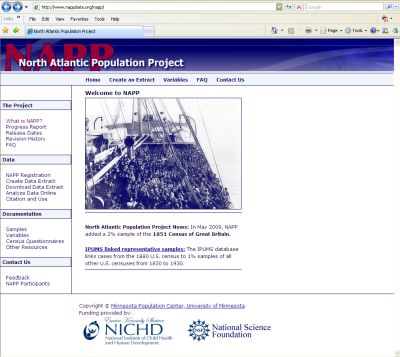 |
Issue 28 (3/2009)
|
|||
FSD Bulletin is the electronic newsletter of the Finnish Social Science Data Archive. The Bulletin provides information and news related to the data archive and social science research.
|
Census Data for Research and StudiesIndividual-Level Information on Millions of PeopleMari Kleemola | Photo by: Charlot Meyer Minnesota Population Center at the University of Minnesota has performed an immense task in assembling microdata from censuses for the use of the scientific community. The project is titled IPUMS, the Integrated Public Use Microdata Series. Two of the most important resources produced by the project are IPUMS-USA and IPUMS-International. NAPP, the North Atlantic Population Project may also be of interest to people living in the Nordic countries.
The resources contain microdata on population, for instance on employment, education, financial circumstances, household composition, fertility, marital status, moving, and housing. The data can be used for instance in researching history, in describing social structures and their changes, and in comparing different societies. Sample Data from US CensusIPUMS-USA contains US census data from 1850-2000. The US Census Bureau conducts censuses at ten-year intervals, next time in 2010. IPUMS-USA consists of about 60 samples drawn from 15 federal censuses. The size of the samples has varied over the years, ranging from 1 per cent to 5 per cent of the whole population. In addition, survey-based data are available from the years between the 2000 and 2010 censuses. International MicrodataAs its name suggests, IPUMS-International is an international census resource consisting of data on 279 million people from 130 censuses conducted in over 40 countries. Several countries from South America, Africa and Europe are represented among others. The resource was last updated in May, when for example geographic information (GIS) data were added to it. Northern Europe Census Data from Late 19th CenturyNAPP, the North Atlantic Population Project, offers a chance to investigate the population of the North Atlantic countries at the end of the 19th century. The unique micro data include the following complete-count censuses: Canada (1881), Great Britain (1881), Iceland (1870, 1880, 1901), Norway (1865, 1900), Sweden (1900), and the United States (1880). The variables in the data have been harmonised to facilitate comparative analyses. The Population Center has conducted the NAPP project in collaboration with the universities of Ottawa, Montreal, Essex, Umeå, Bergen and Tromsø, the Statistics Iceland, the National Archives of Sweden, and the Stockholm City Archives.
Analyse Online or Download, Free of ChargeAll IPUMS resources have been extensively documented. The project websites contain for example variable lists. Data can be analysed online, and for instance performing various cross tabulations is fast. Registered users can download microdata to their computers for deeper analyses. IPUMS supports the most common statistical software (SPSS, SAS and Stata). Data are available for scientific research and teaching. It is free to register and to use the data. Thousands of Users and Terabytes of Data ServedAccording to Trent Alexander, the Project Coordinator for IPUMS-USA, IPUMS-USA, IPUMS-International and NAPP combined received about 2 million page views coming from 40,000 unique visitors in the past year. "The majority of users are naturally from the USA, but we also have plenty of visitors from Canada, the UK, Spain, Germany, Sweden, Mexico, France, Brazil, and Norway", Alexander says. Alexander points out that each resource has users from Finland as well. "We have a couple of dozens of registered users from Finland", he says. Minnesota Population Center collects information on books, articles and theses in which the data have been utilised. At the moment, there are about 3,000 items in the bibliography on the website. In addition, there is an ongoing competition offering prizes for the best publications utilising IPUMS data. "There are separate categories for advanced scientists and students in the competition. The deadline for submitting a publication to the competition is the end of this year", Alexander says. Due to a large number of users and large file sizes, giga- and terabytes of data are served over the Internet. Peter Clark, Information Technology Core Director at the Minnesota Population Center, provides an example: "The last week of September was fairly typical. IPUMS-USA, which is our most popular project, disseminated 376 custom data extracts, comprising 45 gigabytes of compressed data, which represents over half a terabyte of uncompressed data. Our other projects disseminated about as much data as IPUMS-USA, so in total we served a terabyte of data in a week."
More information:
|

